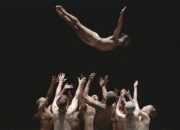
This compelling powerful documentary tells the story behind the most celebrated and performed work by the iconic queer choreographer Bill T Jones. He created ‘D-Man In The Waters’ in 1989 one year after losing his life partner the dancer/choreographer Arnie Zane to AIDS. It was the height of the pandemic that was decimating the queer community robbing us not just of lovers and friends but also some of the great cultural figures of that generation.
A devastated Jones involved his Bill T. Jones/Arnie Zane Dance Company in creating the new ‘dance’ that was both an elegy for Zane and part of his effort to raise awareness of the sheer horrors of the disease. Demian Acquavella was one of the leading company members at the time who had already been diagnosed, and we see from archival footage how this stunning dancer, known as D-Man, refused to let his illness determine his life. Two of the most heartbreaking scenes in this documentary involve him: once when he and a fellow dancer perform a duet with their foreheads touching throughout. Secondly is the night in 1989 at the premiere of the D-Man when Jones carries a very week Acquavella onto the stage just so that he can be part of this very important evening.
 However, Rosalynde LeBlanc, one of the film co-directors brings the story of D-Man right up to date as she now teaches the dance to Loyola Marymount University students. She was a former member of Jones’ company (she said she decided to become a dancer after seeing “D-Man in the Waters” when she was 16 years old). Now she places as much importance on the relevance of the piece rather than just the sheer (very difficult) technical dance moves. By talking to her young Company about AIDS, or which very shockingly they know little off, she slowly drags out of them what current-day issues are on their mind.
However, Rosalynde LeBlanc, one of the film co-directors brings the story of D-Man right up to date as she now teaches the dance to Loyola Marymount University students. She was a former member of Jones’ company (she said she decided to become a dancer after seeing “D-Man in the Waters” when she was 16 years old). Now she places as much importance on the relevance of the piece rather than just the sheer (very difficult) technical dance moves. By talking to her young Company about AIDS, or which very shockingly they know little off, she slowly drags out of them what current-day issues are on their mind.
With Jones’s input, LeBlanc explains to them (and us too) that the social significance of ‘D-Man” goes way beyond the AIDS pandemic. It’s an important lesson her dancers take great pride in adopting, and which makes the whole documentary so much more than we the audience had bargained for.
There is a lot of Jones himself in the film, both archival and in the present, and although ‘D-Man’ is the subject and not him, LeBlanc succinctly captures the true essence of this beautiful human being.

